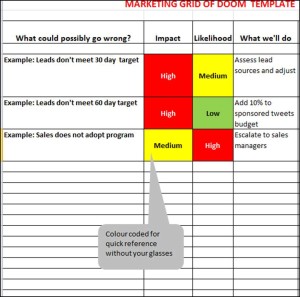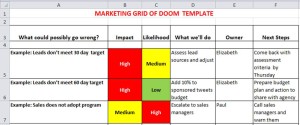Last week we considered the importance of scenario planning for marketing and PR. Just like our friends in HR and IT, marketers need to have at least a vague idea of how they would respond to really bad things that could hurt their brand.
This week, we’ll turn our attention from scenario planning involving zombies, infections and horrible competitors and look instead at marketing risk assessment for the stuff that is likely to happen. Take a look at your calendar from the past few months. How many hours of your time have been spent in meetings that deal with problems?
Whether it’s working out what to do about a particularly cranky group of customers sounding off on social media, or trying to deal with a campaign that isn’t delivering, or reassuring your Sales Squirrels that the phone will start ringing any old day now, you are probably doing your share of trouble-shooting and explaining.
Once that’s over with, you’re scuttling back to the marketing department and huddling around a flip chart to figure out what to do next so you can go to another meeting and propose a solution to the thing that you really didn’t think would go wrong but obviously has.
Let’s be honest here, Lords and Ladies of the Spin Cycle, you sort of knew that you might be dealing with this problem, didn’t you? It flashed across your busy brain months ago, as you laid out your plans and forecasted your traffic and allocated your budget. But you’re a glass-half-full kind of person so you whistled through it and hoped the Universe would make it all work out in the end.
I’m going to suggest that at least 80 percent of the problems you are currently trying to hose down are not really a surprise to you. I know that about 90 percent of the stupid stuff on my list right now is stuff I really could have seen coming. So let’s agree to do this simple thing as we sit down to map out the next big campaign or product launch or event – let’s do a little risk assessment.
Why marketing risk assessment is a good thing
- It will save you countless hours and arguing later
- It may prevent a few meetings (in fairness, it may cause some too)
- Your Hand-Wringers will be very pleasantly surprised at your planning rigour
- You will be not be unpleasantly surprised when it all goes to hell
- It may flag projects that are really terrible ideas before they become really terrible market-facing activities
This needn’t take long, and the best news is, you can probably reuse a lot of your little scenarios and responses over and over again in other activities. Here’s how I tackle it.
BizMarketer’s four steps to doing a marketing risk assessment
- Make sure a risk discussion is on your agenda. You won’t do it if it isn’t part of your planning discussion.
- As you muck through each tactic or strategy, spend a couple of minutes challenging each other on things that could go wrong (see my helpful list below if you’re having trouble)
- Use the grid below to capture the stuff you agree could go wrong – you don’t need to solve it; just note it so you don’t forget about it
- Before you head out to celebrate your strategic brilliance, pull up your grid and start working through it. Don’t stop until you have it all done.
The Grid of Doom:
I’ve used this format for years, but I’m sure there are others that are just as useful. It’s really as simple as listing the stuff that could go wrong on the left, deciding how likely it is to actually happen (be honest), how bad it will be if it does happen (it helps to imagine the discussion you will have with your Corporate Overlords) and, one or two lines on how you plan to deal with it if it does happen.
It’s okay to have a question mark in the right-most column; not everything is necessarily yours to solve. The important thing is you’ve at least thought of it. I’ve put the .xls file at the end if you want to download it.
Hooray. Now you get to go to the pub. But not for too long.
If you have any items on the list that have a moderate or high likelihood and/or a moderate or high impact, you need to spend a bit more time on your planning for the right-most column. I like to add a few columns to my grid, or start a whole new one for these babies.
The point of your marketing risk assessment grid is to make sure a real human owner is responsible for figuring out what to do in case one of these bad things happens, and to get whatever passes for consensus in your organization that their idea for solving the bad thing is a good idea.
That’s really it. Another benefit of assessing smaller scenarios is that it may flag some inherently terrible projects or campaigns at the planning stage. If your Grid of Doom has mostly high risk/high impact stuff on it, you may want to rethink the whole shebang.
If you are looking for some help getting started with the stuff that could go wrong, here are a few scenarios I’ve mapped out over the years.
Marketing risk assessment starter kit:
- What happens if campaign doesn’t hit target in 30/60/90 days?
- What if we exceed target and the call centre can’t scale?
- What if we hit an inventory issue?
- What if our competitors match/beat our pricing?
- What if leads are too low?
- What if sales adoption is low?
- What if costs escalate?
- What if we burn our keyword budget too fast?
- What if nobody comes to our event?
- What if our keynote speaker cancels?
- What if opex is cut next quarter?
BizMarketer Grid of Doom Template
Related Posts
When Bad Assumptions Happen to Smart Marketers
The Furry Dead Things at the Unimpressed Feet of Sales
BizMarketer is written by Elizabeth Williams
I help companies have better conversations
Drop me a line at ewilliams@candlerchase.com
Or follow me @bizmkter


Leave a Reply
You must be logged in to post a comment.